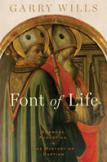Father Figures
Scholar and prolific author Garry Wills knows St. Augustine. In 1999 he published a biography of Augustine in the Penguin Lives series. Soon after, his translations of several books of the Confessions were published individually, and in 2006 his complete translation appeared. In 2011 he published a biography of the book itself, The Confessions, in the Princeton series Lives of Great Religious Books.
In the 1999 biography, Wills described the baptistry that lies under the steps to the Duomo, Milan’s magnificent cathedral. Covered for centuries by rubble and construction, it came to light in World War II when workers were digging out a bomb shelter; further excavations came with the construction of Milan’s Metro. Of this baptistry Wills wrote: “There are few places in Europe more charged with historical significance than this baptistry where Ambrose, the creator of structured disciplines for the medieval Church, received as a Christian Augustine, the creator of the theology that would resound in that Church.” He expressed the same judgment in the introduction to his Confessions.
Now, in Font of Life: Ambrose, Augustine, and the Mystery of Baptism Wills explores this judgment. Bringing profound familiarity with original sources and mastery of contemporary scholarship, he studies these two vastly different giant personalities, their backgrounds, their theologies and their ministries as bishops. Throughout this study, the author’s affection for his subjects fills out the human picture.
Wills first explores the geography of Milan, where Ambrose (bishop from 374 to 397) constructed a ring of churches, establishing his authority around the city. The son of a provincial administrator, he too was in government service until the people of Milan acclaimed him their bishop. Milan was then an imperial capital, and Ambrose never hesitated to confront emperors when he felt his church’s authority was under attack. His personality is a force in Milan today, where one hears of Ambrosian chant, Ambrosian citizens, Ambrosian clergy.
Augustine entered this picture in 384, when he moved from Rome to Milan as a court orator, teacher and scholar. He describes the move simply in Confessions: “I came to Milan, to Ambrose the bishop, known among the best all over the world, your devoted servant”; he goes on to praise Ambrose’s service. From this many have concluded that Ambrose converted Augustine, but Wills disproves this, quickly pointing out their strained relationship. Augustine was going through great struggles in his soul— “boiling, seething,” as he put it—and Ambrose had no time for him. Augustine was disappointed with the great man.
Augustine did come to faith, though, and Ambrose did in fact help him learn to read and interpret Scripture correctly. So in the dramatic predawn of Easter morning in April 387, Augustine approached the baptistry, went through the lengthy ritual and was baptized by Ambrose. A few months later, Augustine returned home to Africa, hoping to live the quiet life of a scholar and writer. But in 395 he was chosen bishop of Hippo, and there went his dreams of a monastic life of prayer and scholarship!
Wills uses this narrative to study Ambrose’s mystical theology and Augustine’s more rational one. He explores their different approaches to baptism and the Eucharist, and he contrasts Ambrose’s mission as bishop in an imperial capital with Augustine’s in the smaller port city of Hippo in North Africa. Both faced religious controversies that had political overtones, though, and here Augustine learned from his elder.
The book surveys the intersection of the lives of two of the Latin patriarchs who left great, if different, marks on the church. It explores theology with narrative flow. It makes its serious points with grace.
This article also appeared in print, under the headline “Father Figures,” in the June 18, 2012, issue.








